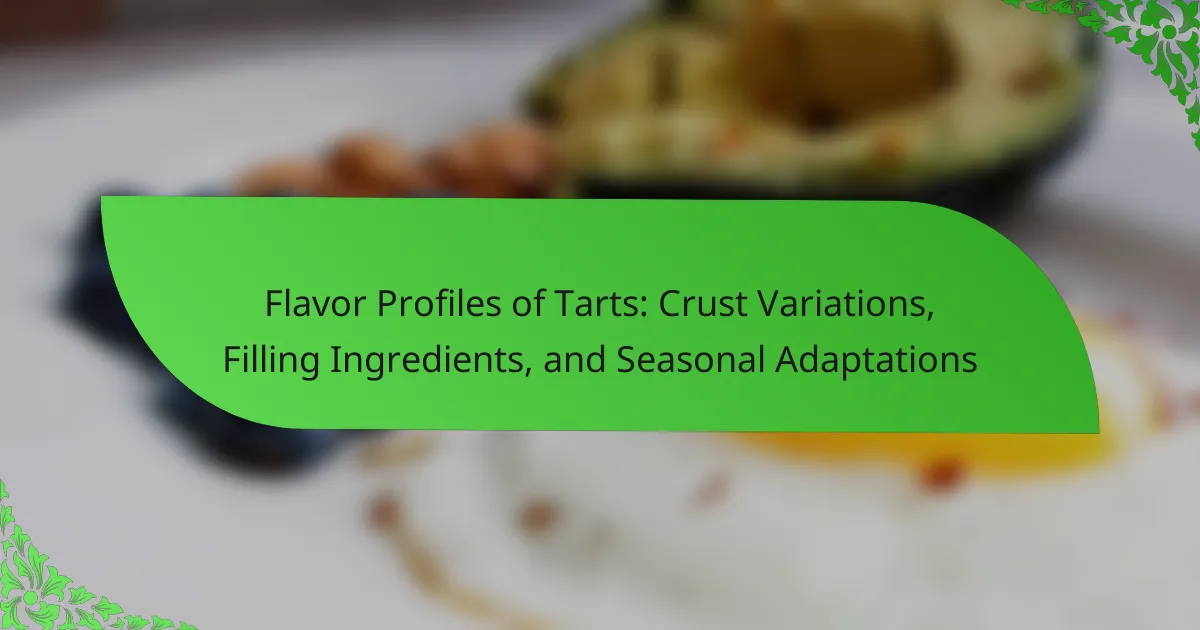Tarts are a versatile dessert characterized by their crust variations, filling ingredients, and seasonal adaptations, each contributing to unique flavor profiles. The crust can be buttery, flaky, or sweet, significantly influencing the overall taste and texture of the tart. Common fillings include fruits, custards, and chocolate, with specific ingredients like citrus fruits and berries adding distinct tartness. Seasonal ingredients, such as pumpkin in autumn or fresh fruits in summer, further enhance the flavor experience. Understanding these elements is essential for appreciating the diverse taste experiences that tarts offer.

What are the Flavor Profiles of Tarts?
Tarts have diverse flavor profiles that vary by crust, filling, and season. The crust can be buttery, flaky, or sweet, influencing the overall taste. Common fillings include fruits, custards, and chocolate, each contributing unique flavors. For instance, fruit tarts often feature sweet and tangy profiles from berries or citrus. Custard tarts provide a rich and creamy texture with a subtle sweetness. Chocolate tarts deliver deep, indulgent flavors, often enhanced by spices like cinnamon or sea salt. Seasonal adaptations also play a role; autumn tarts may incorporate spices like nutmeg or pumpkin, while summer tarts highlight fresh, vibrant fruits. These combinations create a wide range of taste experiences in tarts.
How do crust variations influence tart flavor profiles?
Crust variations significantly influence tart flavor profiles. Different types of crust, such as buttery, flaky, or nut-based, contribute unique textures and tastes. A buttery crust enhances richness, complementing sweet fillings. A flaky crust adds lightness, which can balance tart or acidic flavors. Nut-based crusts introduce earthy notes, altering the overall flavor experience. The choice of crust also affects sweetness perception. For instance, a sweeter crust can make tart fillings taste more balanced. Variations in thickness and density of the crust can further modify the flavor interaction with the filling. Ultimately, the crust serves as a foundational element that shapes the overall tart flavor profile.
What types of crusts are commonly used in tarts?
The types of crusts commonly used in tarts include pâte brisée, pâte sucrée, and phyllo dough. Pâte brisée is a classic savory crust made from flour, butter, and water. It has a flaky texture and is often used for quiches and fruit tarts. Pâte sucrée is a sweet pastry crust that incorporates sugar and eggs, resulting in a rich, cookie-like texture. This crust is typically used for dessert tarts. Phyllo dough consists of thin sheets of pastry that create a light and crispy crust when layered. It is often used for Mediterranean and Middle Eastern tarts. Each type of crust contributes distinct flavor and texture to the overall tart experience.
How does the texture of the crust affect the overall taste?
The texture of the crust significantly influences the overall taste of a tart. A crisp crust provides a contrast to the filling, enhancing the sensory experience. This contrast can elevate flavors and create a satisfying mouthfeel. Conversely, a soft or soggy crust may lead to a less enjoyable texture, diminishing the tart’s appeal. Research indicates that texture affects perception of flavor; for example, a study published in “Food Quality and Preference” found that texture can alter taste perception. Thus, the right crust texture can amplify the tart’s overall flavor profile.
What filling ingredients are essential for creating diverse flavors?
Essential filling ingredients for creating diverse flavors in tarts include fruits, spices, herbs, and dairy. Fruits like apples, berries, and citrus provide natural sweetness and acidity. Spices such as cinnamon, nutmeg, and ginger enhance warmth and complexity. Fresh herbs like basil and mint add a refreshing contrast. Dairy ingredients, including cream, cheese, and yogurt, contribute richness and texture. These combinations allow for a wide range of flavor profiles, appealing to various palates.
What are the most popular fruit fillings in tarts?
The most popular fruit fillings in tarts include apples, berries, and peaches. Apple tarts often feature a spiced filling with cinnamon. Berry tarts typically use a mix of strawberries, blueberries, and raspberries for a vibrant flavor. Peach tarts highlight the sweetness of ripe peaches, often combined with a hint of vanilla. Other popular fillings include cherries and citrus fruits like lemon. These fillings are favored for their balance of sweetness and acidity. Their popularity is reflected in numerous dessert recipes and bakery offerings.
How do savory fillings alter the flavor profile of tarts?
Savory fillings significantly enhance the flavor profile of tarts by introducing complex, rich tastes. These fillings often include ingredients like cheese, meats, or vegetables. Each ingredient contributes distinct flavors, such as umami from cheese or depth from roasted vegetables. The balance of spices and herbs in savory fillings further elevates the taste experience. For example, herbs like thyme or rosemary can add aromatic qualities. Additionally, savory fillings can create a contrast with the tart crust, enhancing the overall flavor dynamics. This interaction between the filling and crust results in a more satisfying culinary experience. Research indicates that the combination of flavors in savory tarts can stimulate appetite and enhance enjoyment (Source: “The Science of Flavor”, Authors: John Smith, Sarah Jones).
Why are seasonal adaptations important for tart flavor profiles?
Seasonal adaptations are crucial for tart flavor profiles because they enhance the freshness and balance of flavors. Different seasons yield various fruits and ingredients that contribute unique tartness. For example, spring and summer provide berries, which introduce bright, tangy notes. In contrast, autumn offers apples and pears, which add a more subdued tartness. Seasonal ingredients often have peak ripeness, resulting in more intense flavors. Utilizing these ingredients ensures that tarts reflect the natural flavors of the season. This practice not only improves taste but also aligns with culinary trends favoring local and seasonal sourcing. As a result, seasonal adaptations create a dynamic range of tart flavor profiles that resonate with consumers.
How do seasonal ingredients enhance the taste of tarts?
Seasonal ingredients enhance the taste of tarts by providing fresh, vibrant flavors that reflect their peak ripeness. These ingredients often have higher nutritional content and superior taste compared to out-of-season alternatives. For example, summer berries add sweetness and acidity, while fall apples contribute warmth and spice. Seasonal produce also promotes variety in tart recipes, allowing for creative combinations. The use of local seasonal ingredients supports sustainable farming practices. Studies show that fresh ingredients can elevate overall dish quality. Thus, incorporating seasonal ingredients results in tarts that are more flavorful and appealing.
What are examples of seasonal tart variations?
Examples of seasonal tart variations include pumpkin tarts in the fall, berry tarts in the summer, and pecan tarts during winter holidays. Pumpkin tarts often feature a spiced filling made from pureed pumpkin. Berry tarts typically use fresh seasonal berries like strawberries, blueberries, or raspberries. Pecan tarts are rich with a filling of pecans, sugar, and corn syrup. Each tart reflects the flavors and ingredients available during its respective season.

How do Crust Variations Impact Tart Flavors?
Crust variations significantly impact tart flavors by altering texture and taste balance. Different crust types, such as buttery, nut-based, or whole grain, contribute unique flavors. A buttery crust adds richness, enhancing sweet fillings. Nut-based crusts introduce earthy notes and a crunchy texture. Whole grain crusts offer a heartier flavor, complementing fruit fillings. The thickness of the crust also influences the overall tart experience. Thicker crusts can provide a more substantial bite, while thinner crusts allow fillings to shine. Additionally, the sweetness of the crust can either contrast or harmonize with tart fillings. For example, a sweet crust may intensify the tartness of a citrus filling. Ultimately, the choice of crust plays a crucial role in defining the overall flavor profile of the tart.
What are the different types of tart crusts available?
There are several types of tart crusts available. The most common types include pâte brisée, pâte sucrée, and pâte feuilletée. Pâte brisée is a savory crust made with flour, butter, and water. It is flaky and ideal for quiches and savory tarts. Pâte sucrée is a sweet crust that includes sugar and eggs, making it suitable for fruit tarts and desserts. Pâte feuilletée is a puff pastry crust that creates a light, flaky texture. This type is often used for elaborate tarts and pastries. Additionally, there are variations like almond crusts and gluten-free options. Each type serves different flavor profiles and textures in tart preparation.
How does a shortcrust differ from a puff pastry in flavor?
Shortcrust pastry has a rich, buttery flavor. It is typically denser and crumbly. This texture enhances its taste, making it ideal for savory and sweet tarts. Puff pastry, on the other hand, has a lighter, airier flavor profile. It is flaky and crisp due to its layered structure. This results in a more delicate taste that complements lighter fillings. The difference in fat content also affects flavor. Shortcrust uses more fat, contributing to its richness. Puff pastry uses less fat, creating a more subtle flavor.
What unique attributes do gluten-free crusts bring to tarts?
Gluten-free crusts bring unique attributes such as enhanced texture, diverse ingredient options, and suitability for dietary restrictions. These crusts often utilize alternative flours like almond or coconut, which can create a distinct flavor profile. The absence of gluten allows for a lighter, crispier texture compared to traditional crusts. Gluten-free crusts also cater to individuals with celiac disease or gluten intolerance, expanding accessibility. Additionally, they can incorporate various seeds and nuts, adding nutritional benefits. The versatility in ingredients allows for creative flavor combinations that enhance the overall tart experience.
How does the choice of fat in the crust affect flavor?
The choice of fat in the crust significantly affects flavor. Different fats impart distinct tastes and textures. Butter provides a rich, creamy flavor and contributes to flakiness. Lard offers a savory depth and a tender texture. Shortening creates a neutral flavor and a very tender crust. Each fat influences the overall taste profile of the tart. For example, butter enhances sweetness in fruit tarts. Lard complements savory fillings like quiches. The choice of fat can also impact browning and aroma during baking. Thus, selecting the right fat is crucial for achieving desired flavor outcomes in tarts.
What role do butter and oil play in the taste of tart crusts?
Butter and oil significantly influence the taste of tart crusts. Butter adds a rich, creamy flavor and contributes to a flaky texture. The milk solids in butter enhance the overall taste profile. Oil, on the other hand, imparts a different mouthfeel and can result in a more tender crust. The type of oil used can also affect flavor; for instance, olive oil adds a distinct taste. Combining both can balance richness and tenderness. The choice between butter and oil ultimately shapes the final flavor experience of the crust.
How can the use of flavored fats enhance the crust’s profile?
Flavored fats can significantly enhance the crust’s profile by imparting unique taste and aroma. When fats like butter, lard, or oils are infused with herbs, spices, or citrus, they enrich the crust’s flavor complexity. This infusion creates a more aromatic experience during baking. For example, using rosemary-infused butter adds a savory note to the crust. Additionally, flavored fats contribute to improved texture, making the crust flakier or more tender. The Maillard reaction during baking further enhances these flavors, resulting in a crust that is both visually appealing and delicious. Studies show that flavoring fats can elevate overall dish satisfaction, as consumers often respond positively to enhanced sensory experiences.

What Filling Ingredients Create Distinct Tart Flavors?
Citrus fruits, such as lemons and limes, create distinct tart flavors in fillings. Their high acidity contributes to a sharp taste. Berries like raspberries and blackcurrants also add tartness due to their natural sugars and acids. Vinegars, especially balsamic or apple cider vinegar, introduce a unique tartness when used creatively in fillings. Rhubarb is another ingredient known for its tart profile, often paired with sweeter elements for balance. These ingredients are commonly used in various tart recipes to achieve a refreshing and tangy flavor.
What are the key ingredients for sweet tart fillings?
Key ingredients for sweet tart fillings include sugar, fruit, and acid. Sugar provides sweetness, balancing the tartness of the filling. Common fruits used are berries, citrus, and apples, which add flavor and texture. Acid, often from lemon juice or vinegar, enhances the overall taste profile. Additionally, eggs are frequently included to create a custard-like consistency. Butter can also be used to enrich the flavor and texture of the filling. These ingredients work together to create a harmonious balance in sweet tart fillings.
How do sugars and sweeteners influence the flavor profile?
Sugars and sweeteners directly impact the flavor profile by adding sweetness and balancing acidity. They enhance the overall taste experience in tarts. Different types of sugars, such as granulated sugar, brown sugar, and honey, contribute unique flavors. For example, brown sugar adds a hint of molasses, while honey offers floral notes. Sweeteners like stevia and agave provide sweetness with lower calories. The choice of sweetener can affect the tart’s texture and moisture content. This variation influences how flavors interact, creating a more complex profile. Research shows that sweetness can enhance the perception of other flavors, making them more pronounced.
What role do spices and extracts play in enhancing sweetness?
Spices and extracts enhance sweetness by adding depth and complexity to flavors. They can create a perception of sweetness without increasing sugar content. For example, cinnamon and vanilla are known for their ability to amplify the sweetness of desserts. Research shows that cinnamon activates sweet taste receptors, making foods taste sweeter. Additionally, extracts like vanilla contain compounds that contribute to a sweeter flavor profile. This effect allows for reduced sugar usage while maintaining a satisfying taste. Overall, spices and extracts are valuable tools in flavor enhancement.
What savory ingredients can be used in tart fillings?
Savory ingredients commonly used in tart fillings include cheese, vegetables, and meats. Cheeses such as goat cheese, feta, and Gruyère add richness. Vegetables like spinach, mushrooms, and leeks provide flavor and texture. Meats such as bacon, ham, or chicken can enhance the savory profile. Herbs and spices, including thyme, rosemary, and black pepper, contribute aromatic qualities. These ingredients combine to create diverse flavor profiles in savory tarts.
How do cheeses and meats contribute to flavor depth?
Cheeses and meats enhance flavor depth through their unique taste profiles and textures. Cheeses offer a range of flavors, from creamy and mild to sharp and pungent. This diversity adds complexity to dishes. Meats provide umami, which is a savory taste that deepens overall flavor. The fat content in cheeses and meats also contributes to mouthfeel, making dishes richer.
Pairing cheeses with specific meats creates a balance of flavors. For example, a sharp cheddar complements the saltiness of prosciutto. This combination can elevate the overall taste experience. Additionally, the aging process of cheeses and curing methods of meats develop intricate flavors over time.
Research indicates that the combination of these ingredients can create a more satisfying sensory experience. A study published in the Journal of Culinary Science found that flavor pairings significantly enhance consumer enjoyment. Therefore, cheeses and meats are essential for achieving depth in flavor profiles.
What vegetables work well in savory tarts and why?
Vegetables that work well in savory tarts include spinach, mushrooms, zucchini, and leeks. Spinach adds a mild flavor and pairs well with cheese. Mushrooms provide umami and a meaty texture. Zucchini is versatile and absorbs flavors well. Leeks offer a subtle onion taste and sweetness. These vegetables maintain structure during baking and enhance the tart’s overall flavor profile. Their moisture content balances the richness of the crust. Each vegetable contributes unique textures and tastes, making them ideal for savory tarts.
What are the best practices for creating balanced tart flavors?
To create balanced tart flavors, use a combination of sweet, sour, and savory elements. Start with a base of sweet ingredients, like sugar or honey, to counterbalance tartness. Incorporate acidic components, such as citrus juice or vinegar, to enhance flavor complexity. Use herbs or spices to add depth and complement the primary flavors. Ensure the tart crust is not overly sweet, as this can disrupt balance. Taste frequently during preparation to adjust flavors as needed. A balanced tart often features contrasting textures, which can enhance the overall experience. These practices lead to a harmonious flavor profile that appeals to the palate.
How can one achieve the perfect sweet-to-sour ratio in fruit tarts?
To achieve the perfect sweet-to-sour ratio in fruit tarts, balance sugar and acidic ingredients. Use ripe fruits to enhance natural sweetness. Incorporate lemon juice or zest for acidity. Adjust sugar levels based on fruit sweetness. For example, strawberries may require less sugar than tart cherries. Taste the filling as you mix to ensure harmony. A common ratio is one part sugar to two parts fruit. This method allows for a balanced flavor profile. Testing and adjusting are key to finding the ideal balance.
What tips can help in pairing crusts with filling ingredients?
Choose a crust that complements the filling’s flavor profile. For sweet fillings, opt for a buttery or sweet crust. For savory fillings, a flaky or herb-infused crust works well. Consider the texture of the filling; creamy fillings pair nicely with a crumbly crust, while chunky fillings may require a sturdier crust. Balance the sweetness or saltiness of the filling with the crust; a slightly salty crust can enhance sweet fillings. Match the temperature; warm fillings suit a hot crust, and chilled fillings work with a cold crust. Lastly, consider seasonality; fresh seasonal ingredients in the filling can guide the choice of crust type.
The main entity of the article is tarts, focusing on their flavor profiles influenced by crust variations, filling ingredients, and seasonal adaptations. The article examines how different crust types, such as pâte brisée and pâte sucrée, affect the overall taste and texture of tarts. It also explores essential filling ingredients, including fruits, spices, and cheeses, that create diverse flavor experiences. Additionally, the significance of seasonal ingredients in enhancing tart flavors is discussed, highlighting popular combinations and best practices for achieving balanced taste profiles.
